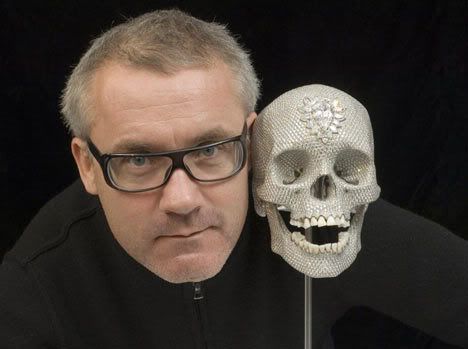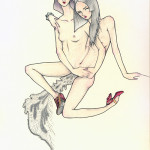Art or Not: Hirst’s “For the Love of God”
by The Fashion Cult
He calls it “a celebration against death.” Damien Hirst, the artist known for his controversial pickled sheep and such pieces, has unveiled his latest work, titled For the Love of God.
The piece is a human skull covered in 8,601 flawless diamonds, including one 52-carat pear-shaped whopper of a stone in the middle of the skull’s forehead. The piece has a stunning £50 million price tag (that’s close to $100 million for us yanks), although the artist reportedly wants the piece to remain in public display for a while before going into private collection.
I’m still undecided on this one. One perspective says the the so-called art is ridiculously self-indulgent, and that Hirst is simply a publicity hound. But then I can’t deny the provocative value of the way the two materials mix. Most of us in the west tend to automatically associate the image of a skull with death – and these are negative associations at that. Meanwhile, the skull has every bit, and perhaps more, to do with life than with death. And then there’s the symbol of the diamond: purity, eternity, luxury… Hirst twists the western mind back on itself by forcing us to simultaneously contemplate something we fear and deny with something after which we lust. It’s true that the subject of diamonds and death (re: Kenye West, the movie “Blood Diamonds” etc.) is something of a fad right now. Perhaps, though, it’s a fad worth encouraging. And afterall, who says art shouldn’t be self-indulgent and attention-seeking. On the contrary, that may be exactly what it’s for.
What do you think? Please leave your comments and links.
Tags: damien hirst, art, skulls, diamonds, fads
Powered by Qumana







Hirst’s work has always had a history with skulls and bones, not just human remains, but remains of many animals. After going to one of his shows in New York I truly respect this mans work. People wish to have this mans budget to create their own work, but if money was not the issue, what would you create? This is an outstanding piece of art. I pay no attention to the value of these stones nor do I care if they are flawless, whatever! Its the relationship between mankind and our passion for value, high status, the elite, the flesh. But in this case the flesh is made of diamonds.
It looks just like someone I know. Iceworm, thats who.
People wear jewelry of foxes or little butterflies decorated with “precious” stones, no problem. Throughout history many culture collect the skulls of important people, to be short. It creates dialog, and interest into the history of this skull and who it belong to.
But overall the craftsmanship that went into this piece places it with some of the highest caliber works. It would be nice to get a skull collectors opinion on this one.
Iceworm
I am not familiar with Hirst’s work.
Infact all humans are nothing untill they begin to show me who they are.
This is the first thing I have ever seen from herst,
to strike at death with a sword of desire or pecieved value is commendable.
But one can use a number of mediums to do this.
Diamonds is a might decadent and speaks to (in my world) a gross minority.
Diamonds are pretty and so is glass.
A plastic skull could work, but it is real.
alot of thought goes into thinking about those points.
A piece that makes you think….well
like it not….
It’s art.
I think personally a piece of art worth more than cuba’s deficit is not as helpful as the schools and improvements that could be made, but it is what it is.
It is art, as decadent as a roman vomitorium, but I’d rather see powder paint and finger prints.
LeonDale.
Hirst, once again, pushes the envelope of what is art. If we follow the trajectory of modernism, along with the death of painting, the death of the object, the death of the author, etc., we can see how Hirst’s “For the Love of God” fits in nicely here – the death of any value inherent in the art work itself. I remember reading an interview with Jeff Koons. Koons was asked if, in fact, he was thematizing the banality of our consumerist culture, why didn’t he use a more precious metal on his objects. While I can’t quote him here, Koons said that he wanted the value of the work to be based on the work itself and not the materials. Hirst responds to this by saying the art object is nothing but pure commodity. Of course, this can be read as the real death of art – the last nail in the coffin.